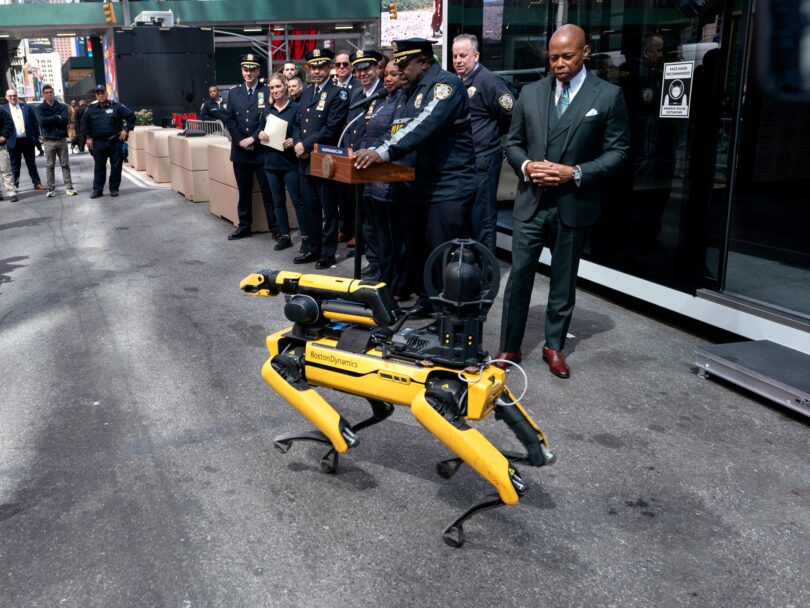Our old friend Spot the robot dog is joining the Big Apple’s police force. New York City mayor Eric Adams announced that the New York Police Department will be acquiring some new semi-autonomous robotic canines in the coming weeks. The move comes almost exactly two years after the NYPD halted its first go at using a camera-carrying robot dog for surveillance, after a massive public outcry; citizens felt it was a dystopian overreach of police power. Now Adams, a former NYPD captain, is moving the program forward again.
The NYPD says it will acquire two of Boston Dynamic’s controversial Spot bots. While the robot dogs have autonomous capabilities, the NYPD says these units won’t be patrolling the streets by themselves just yet. Instead, the robodogs will be deployed in specific instances where the danger for humans is high, much like the bomb-squad robots the department already uses. Each Spot will cost about $75,000, with the cameras and sensors attached to their bodies costing extra.
Spot is not the only robot rookie joining the NYPD. The department is also testing the use of a Knightscope K5 robot. The human-sized, ovoid K5 is equipped with cameras, sensors, and speakers. It’s meant to patrol and surveil its surroundings, detering break-ins and vandalism. This is not the K5’s first time out in public. The wheeled bots have been deployed in test cases to spy on the streets in places like Silicon Valley in California, where they’ve mostly been met with mocking suspicion and drunken violence. People on the streets don’t take kindly to these Dalek-like narcs, and every now and then somebody kicks the crap out of one. After all, they do tend to be very kickable. Letting more of them roam the already jam-packed New York streets—or the city’s subway stations—will likely garner them plenty of dirty looks and occasional beatings.
Here’s what else happened this week.
Parks Recreation
The weather is finally clearing up enough for us to get out in nature—and just in time, Google has announced an update to Maps that will help people navigate the sprawling national park system.
The update will better show the layout and features of all national parks in the US. It will offer more detailed directions on bike routes, on trails, and within campgrounds, and it will highlight whole trail routes instead of just showing a pin at the location of the trailhead, to give users a better idea of what a hike entails. Hopefully the features will work better than Google’s regular search engine, and you won’t have to append “+Reddit” to find anything useful in the results.
Google’s Maps updates are coming in April for US national parks, and the company says it will slowly add parks across the world in the next few months.
iOSwiftKey
It wouldn’t be a news story on the internet these days without a dash of machine intelligence. Last week, Microsoft slipped its generative-AI-powered Bing Chat bot into SwiftKey, an app that lets you type words on your phone by using swipes and gestures on the keyboard. The Bing-enabled update was only available for Android, but now the feature has been added to the iOS version as well.
SwiftKey has had a strained relationship with iOS lately. Microsoft removed the app from Apple’s App store last year, then quickly reinstated it.
Speaking of AI …
Talkin’ ’bout My Voice Generation
We’ve entered the age of the AI voice clone. Nearly anyone can take a few short clips of someone talking, feed it into a generative AI audio program, and then be able to create a human-ish sounding voice that can say whatever you can type out on a keyboard.
Like the rest of the ongoing AI upheaval, that might sound alarming. And it is, when the software is used for terrible purposes like making celebrity voice clones say racist things or scamming people by mimicking the desperate voices of their loved ones on a phone call. However, the tech has more positive uses, too. It could be used to generate voices for people who have lost theirs, or preserve the voices of people long past. Some companies are even building voice clone services aimed at content creators like YouTubers, podcasters, or audiobook narrators.
This week on Gadget Lab, we talk about how good—and occasionally alarming—voice AI has gotten, and what happens when the tech gets to the point where you can’t tell the difference between the human and the computer.





